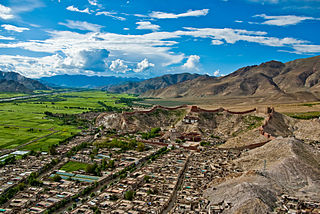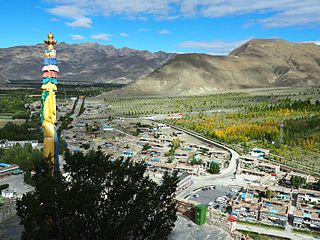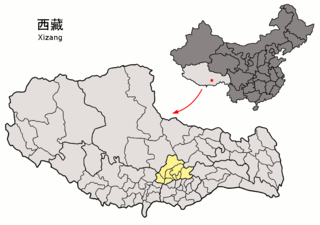
Dalai Lama is a title given by the Tibetan people to the foremost spiritual leader of the Gelug or "Yellow Hat" school of Tibetan Buddhism, the newest and most dominant of the four major schools of Tibetan Buddhism. The 14th and current Dalai Lama is Tenzin Gyatso, who lives as a refugee in India. The Dalai Lama is also considered to be the successor in a line of tulkus who are believed to be incarnations of Avalokiteśvara, the Bodhisattva of Compassion.

Tibet is a region in East Asia, covering much of the Tibetan Plateau and spanning about 2,500,000 km2 (970,000 sq mi). It is the traditional homeland of the Tibetan people as well as some other ethnic groups such as Monpa, Tamang, Qiang, Sherpa and Lhoba peoples and is now also home to considerable numbers of Han Chinese and Hui people settlers. Tibet is the highest region on Earth, with an average elevation of 4,380 m (14,000 ft). Located in the Himalayas, the highest elevation in Tibet is Mount Everest, Earth's highest mountain, rising 8,848.86 m (29,032 ft) above sea level.

The Tibet Autonomous Region (TAR) or Xizang Autonomous Region, often shortened to Tibet or Xizang, is a province-level autonomous region of the People's Republic of China in Southwest China. It was overlayed on the traditional Tibetan regions of Ü-Tsang and Kham.

Lhasa is the urban center of the prefecture-level Lhasa City and the administrative capital of Tibet Autonomous Region in Southwest China. The inner urban area of Lhasa City is equivalent to the administrative borders of Chengguan District, which is part of the wider prefectural Lhasa City.

Heinrich Harrer was an Austrian mountaineer, sportsman, geographer, Oberscharführer in the Schutzstaffel , and author. He was a member of the four-man climbing team that made the first ascent of the North Face of the Eiger, the "last problem" of the Alps. He wrote the books Seven Years in Tibet (1952) and The White Spider (1959).

Robert Alexander Farrar Thurman is an American Buddhist author and academic who has written, edited, and translated several books on Tibetan Buddhism. He was the Je Tsongkhapa Professor of Indo-Tibetan Buddhist Studies at Columbia University, before retiring in June 2019. This was the first endowed chair in Buddhist Studies in the West. He also is the co-founder and president of the Tibet House US New York. He translated the Vimalakirti Sutra from the Tibetan Kanjur into English. He is the father of actress Uma Thurman.

Samzhubzê District is a district in the Tibet Autonomous Region of the China, and the administrative center of the prefecture-level city of Shigatse. Prior to 2014 it was known as the county-level city of Shigatse. It was the ancient capital of Ü-Tsang province and is the second largest city in Tibet with an estimated population of 117,000 in 2013. Samzhubzê is located at the confluence of the Yarlung Tsangpo River and the Nyang River, about 250 km (160 mi) southwest of Lhasa and 90 km (56 mi) northwest of Gyantse, at an altitude of 3,840 metres (12,600 ft).

The Jokhang, also known as the Qoikang Monastery, Jokang, Jokhang Temple, Jokhang Monastery and Zuglagkang, is a Buddhist temple in Barkhor Square in Lhasa, the capital city of Tibet Autonomous Region of China. Tibetans, in general, consider this temple as the most sacred and important temple in Tibet. The temple is currently maintained by the Gelug school, but they accept worshipers from all sects of Buddhism. The temple's architectural style is a mixture of Indian vihara design, Tibetan and Nepalese design.

Songtsen Gampo, also Songzan Ganbu, was the 33rd Tibetan king and founder of the Tibetan Empire, and is traditionally credited with the introduction of Buddhism to Tibet, influenced by his Nepali consort Bhrikuti, of Nepal's Licchavi dynasty, as well as with the unification of what had previously been several Tibetan kingdoms. He is also regarded as responsible for the creation of the Tibetan script and therefore the establishment of Classical Tibetan, the language spoken in his region at the time, as the literary language of Tibet.

Gyantse, officially Gyangzê Town, is a town located in Gyantse County, Shigatse Prefecture, Tibet Autonomous Region, China. It was historically considered the third largest and most prominent town in the Tibet region, but there are now at least ten larger Tibetan cities.

Shigatse, officially known as Xigazê, is a prefecture-level city of the Tibet Autonomous Region of the People's Republic of China. Its area of jurisdiction, with an area of 182,000 km2 (70,271 sq mi), corresponds to the historical Tsang region of Tibet.

Tashi Lhunpo Monastery, founded in 1447 by the 1st Dalai Lama, is the traditional monastic seat of the Panchen Lama, and an historically and culturally important monastery in Shigatse, the second-largest city in Tibet.

Dêqên Tibetan Autonomous Prefecture, also known as Diqing Tibetan Autonomous Prefecture is an autonomous prefecture in Northwestern Yunnan Province, China. It has an area of 23,870 km2 (9,220 sq mi). Its capital, which is also the largest city in the prefecture, is Shangri-La City.

Shannan, also transliterated from Tibetan as Lhoka, is a prefecture-level city in the southeastern Tibet Autonomous Region, China. Shannan includes Gonggar County within its jurisdiction with Gongkar Chö Monastery, Gonggar Dzong, and Gonggar Airport all located near Gonggar town.

Seven Years in Tibet is a 1997 American biographical war drama film directed by Jean-Jacques Annaud. It is based on Austrian mountaineer and Schutzstaffel (SS) officer Heinrich Harrer's 1952 memoir Seven Years in Tibet, about his experiences in Tibet between 1944 and 1951. Seven Years in Tibet stars Brad Pitt and David Thewlis, and has music composed by John Williams with a feature performance by cellist Yo-Yo Ma.

The 1959 Tibetan uprising began on 10 March 1959, when a revolt erupted in Lhasa, the capital of Tibet, which had been under the effective control of the People's Republic of China since the Seventeen Point Agreement was reached in 1951. The initial uprising occurred amid general Chinese-Tibetan tensions and in a context of confusion, as Tibetan protestors feared that the Chinese government might arrest the 14th Dalai Lama. The protests were also fuelled by anti-Chinese sentiment and separatism. At first, the uprising consisted of mostly peaceful protests, but clashes quickly erupted and the Chinese People's Liberation Army (PLA) eventually used force to put down the protestors, some of whom had captured arms. The last stages of the uprising included heavy fighting, with high civilian and military losses. The 14th Dalai Lama escaped from Lhasa, while the city was fully retaken by Chinese security forces on 23 March 1959. Thousands were killed during the 1959 uprising, although the exact number is disputed.
The International Tibet Independence Movement (ITIM) is a non-profit organization, founded on 18 March 1995, that supports Tibetan independence from the People's Republic of China:

Lhasa is a prefecture-level city, one of the main administrative divisions of the Tibet Autonomous Region of China. It covers an area of 29,274 square kilometres (11,303 sq mi) of rugged and sparsely populated terrain. Its capital and largest city is Lhasa, with around 300,000 residents, which mostly corresponds with the administrative Chengguan District, while its suburbs extend into Doilungdêqên District and Dagzê District. The consolidated prefecture-level city contains additional five, mostly rural, counties.
Little Tibet is an Asian ethnic enclave within the neighbourhood of Parkdale in Toronto, Ontario, Canada. The area bound by Queen St. W. to the north, the Gardiner Expressway to the west and south, and Atlantic Avenue to the east is known for its many Tibetan émigrés and Tibetan-related businesses and restaurants. There is also a growing Tibetan community nearby in South Etobicoke.

This article documents the situation of the COVID-19 pandemic in the Tibet Autonomous Region.




















